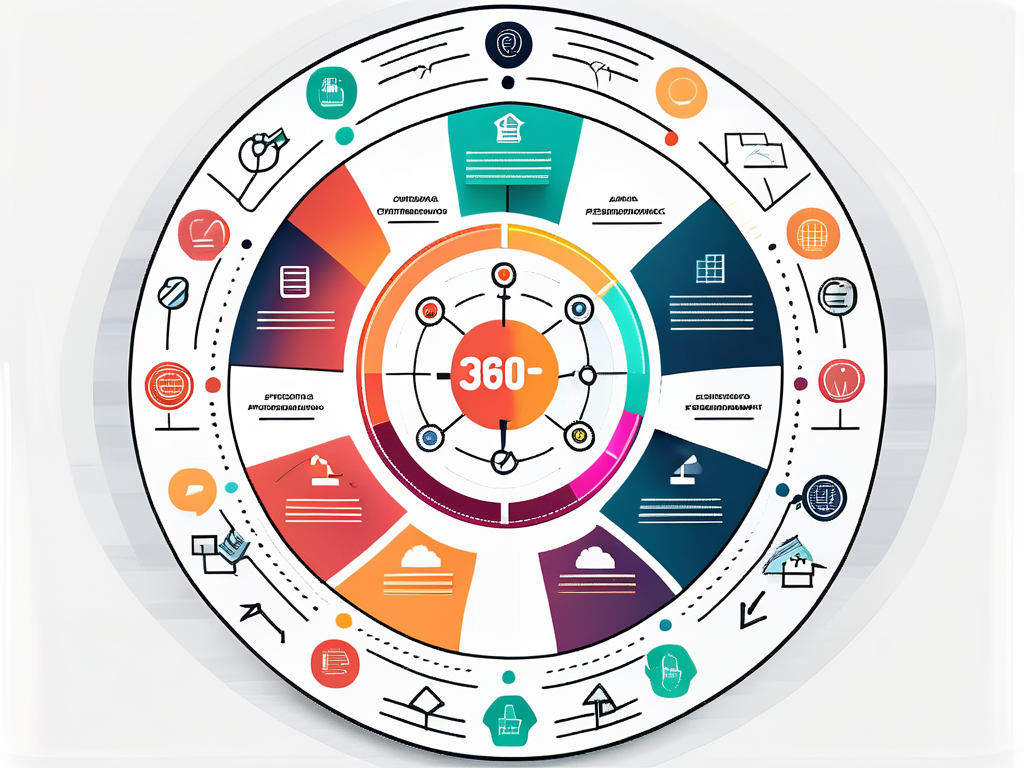
In today’s fast-paced business environment, organisations are constantly seeking ways to enhance employee performance and foster a culture of open communication. One effective tool that has gained popularity in recent years is 360 feedback appraisal. This comprehensive assessment provides individuals with feedback from various sources, including colleagues, subordinates, and supervisors, offering a well-rounded perspective on their performance and behaviour.
Understanding the 360 Feedback Appraisal
Before delving into the details of implementing and measuring the effectiveness of 360 feedback appraisal, it is crucial to understand its definition and purpose. At its core, a 360 feedback appraisal is a multi-rater assessment process that provides individuals with a comprehensive view of their strengths, weaknesses, and areas for development. This feedback is gathered from multiple perspectives, such as peers, direct reports, and supervisors.
Definition and Purpose of 360 Feedback Appraisal
The central concept behind 360 feedback appraisal is to provide individuals with a holistic view of their performance, allowing them to gain insights into their strengths and areas that require improvement. Unlike traditional performance appraisal methods that rely solely on the feedback of supervisors, 360 feedback appraisal leverages the power of feedback from various sources, leading to a more comprehensive assessment.
Key Components of 360 Feedback Appraisal
There are several essential components of 360 feedback appraisal that organisations should be aware of before implementing this assessment tool. Firstly, the selection of raters is crucial to ensure a well-rounded perspective. Including individuals who interact closely with the individual being assessed, such as colleagues and subordinates, provides valuable insights. Secondly, the feedback process should be anonymous to promote honest and constructive feedback. Lastly, the feedback gathered should be focused on specific behaviours and competencies that align with the organisation’s goals and values.
Now, let’s dive deeper into the selection of raters. When choosing individuals to participate in the 360 feedback appraisal process, it is important to consider their proximity to the individual being assessed. Peers who work closely with the individual can provide valuable insights into their day-to-day interactions, teamwork skills, and collaboration abilities. Direct reports, on the other hand, can shed light on the individual’s leadership style, communication effectiveness, and ability to delegate tasks.
Additionally, supervisors play a crucial role in the 360 feedback appraisal process. Their perspective can provide insights into the individual’s overall performance, strategic thinking, and ability to meet organisational objectives. By including supervisors as raters, organisations can ensure a well-rounded assessment that encompasses both the individual’s immediate work environment and their contribution to the broader organisational goals.
Another important aspect of the 360 feedback appraisal process is the anonymity of the feedback. By maintaining anonymity, organizations create a safe space for raters to provide honest and constructive feedback without fear of retribution or bias. This fosters a culture of openness and trust, allowing individuals to receive feedback that is genuine and actionable. It also encourages raters to provide feedback based on their observations and experiences, rather than being influenced by personal relationships or office politics.
Lastly, the feedback gathered through the 360 feedback appraisal process should be focused on specific behaviours and competencies that align with the organisation’s goals and values. By defining clear criteria for evaluation, organisations can ensure that the feedback provided is relevant and actionable. This allows individuals to identify areas for improvement and develop targeted development plans that address their specific needs.
In conclusion, the 360 feedback appraisal is a powerful tool that provides individuals with a comprehensive view of their performance. By leveraging feedback from multiple perspectives, organisations can gain valuable insights into the strengths and areas for development of their employees. With careful selection of raters, anonymous feedback, and a focus on specific behaviours and competencies, organisations can implement a robust 360 feedback appraisal process that drives individual growth and organisational success.
The Importance of 360 Feedback in Organisations
360 feedback appraisal plays a vital role in enhancing employee development and promoting a culture of open communication within organisations. By adopting this assessment approach, organisations can unlock numerous benefits, including:
Enhancing Employee Development
360 feedback appraisal provides individuals with a comprehensive understanding of their performance and areas for improvement. This knowledge serves as a foundation for personalised development plans that address key developmental needs. By aligning individual development goals with organisational objectives, employees can enhance their skills and contribute more effectively to the organisation’s success.
Promoting a Culture of Open Communication
Traditional performance appraisal methods often lack the breadth and depth of feedback that 360 feedback appraisal offers. By involving multiple perspectives and encouraging honest feedback, organisations can foster a culture of open communication. This transparent environment promotes trust and collaboration among team members, ultimately leading to improved teamwork and employee engagement.
Moreover, the 360 feedback process not only benefits individual employees but also contributes to the overall organisational growth. By identifying common themes and trends in feedback across different levels and departments, organisations can pinpoint areas of strength and areas needing improvement on a broader scale. This macro view enables leaders to make informed decisions regarding training initiatives, resource allocation, and strategic planning to drive the organisation forward.
Additionally, the multi-source feedback gathered through 360 appraisals can uncover hidden talents and potential within the workforce. Employees may receive feedback from peers, subordinates, and supervisors that highlight skills or qualities they were previously unaware of. This newfound awareness can lead to opportunities for career advancement, role expansion, or specialized training, benefiting both the individual and the organization as a whole.

Steps to Introduce a 360 Feedback Appraisal
- Define the purpose and goals: Clearly articulate why the organisation is implementing a 360 feedback appraisal system and what it hopes to achieve.
- Select and train raters: Identify the appropriate individuals who will provide feedback and ensure they are trained on the assessment process and guidelines.
- Communicate the process: Clear and transparent communication is essential to gain buy-in from participants and set expectations for the feedback process.
- Collect and analyse feedback: Utilise a secure and reliable platform to gather anonymous feedback from raters and analyse the results to identify patterns and areas for improvement.
- Provide feedback and support: Facilitate feedback sessions with individuals to discuss their assessment results, focusing on their strengths, areas for development, and potential action plans.
Common Challenges and Solutions in Implementation
- Lack of buy-in from participants: To mitigate this challenge, organisations should ensure that all stakeholders are engaged and understand the benefits of the 360 feedback appraisal.
Resistance to change: Implementing a new assessment method can be met with resistance. Address this challenge by providing clear communication and emphasising the positive impact of the 360 feedback appraisal.
Difficulty in maintaining anonymity: To uphold anonymity, organisations should use a trusted platform that guarantees confidential and secure feedback collection and analysis.
Lack of proper training: Offer comprehensive training programs for both raters and individuals being assessed to ensure they understand the purpose, process, and guidelines of the 360 feedback appraisal system.
Best Practices for 360 Feedback Appraisal
Implementing a successful 360 feedback appraisal system requires adhering to certain best practices. These practices ensure the effectiveness and credibility of the assessment process:
Ensuring Anonymity and Confidentiality
One of the critical aspects of 360 feedback appraisal is maintaining anonymity and confidentiality. The feedback provided should be secure and protected, giving participants the confidence to provide honest input without fearing any negative repercussions. Organisations should utilise trusted platforms that prioritise data protection and privacy.
Providing Constructive Feedback
Effective feedback is essential for personal growth and development. Raters should be encouraged to provide actionable and constructive feedback that focuses on behaviour and competencies rather than personal attributes. Additionally, the feedback should be specific, measurable, attainable, relevant, and time-bound (SMART), facilitating clear communication and goal setting.
Measuring the Effectiveness of 360 Feedback Appraisal
Continuous improvement is crucial in any assessment process. Measuring the effectiveness of the 360 feedback appraisal allows organisations to evaluate its impact and make necessary adjustments. Key Performance Indicators (KPIs) can help in this assessment:
Key Performance Indicators (KPIs) for 360 Feedback
- Participation rate: Measure the percentage of individuals who actively participate in the 360 feedback appraisal process, reflecting the overall engagement and acceptance of the assessment.
Feedback quality: Assess the quality of feedback provided, focusing on its specificity, relevance, and effectiveness in driving individual development.
Development plan implementation: Evaluate the extent to which individuals successfully implement their identified development plans, demonstrating the impact of the 360 feedback appraisal on personal growth.
Behavioural change: Measure any noticeable behavioural changes in individuals following the 360 feedback appraisal, indicating the effectiveness of the assessment in influencing positive change.
Continuous Improvement of the 360 Feedback Process
Measuring KPIs enables organisations to identify areas for improvement in the 360 feedback appraisal process. Regular review and evaluation of the assessment process, based on participant feedback and KPI analysis, are essential to fine-tune the system and enhance its effectiveness.
As organisations strive to create a high-performance culture and nurture employee development, 360 feedback appraisal plays a vital role. By understanding the key concepts, implementing best practices, and measuring its effectiveness, organisations can leverage the power of 360 feedback appraisal to unlock the full potential of their employees and drive organisational success.
